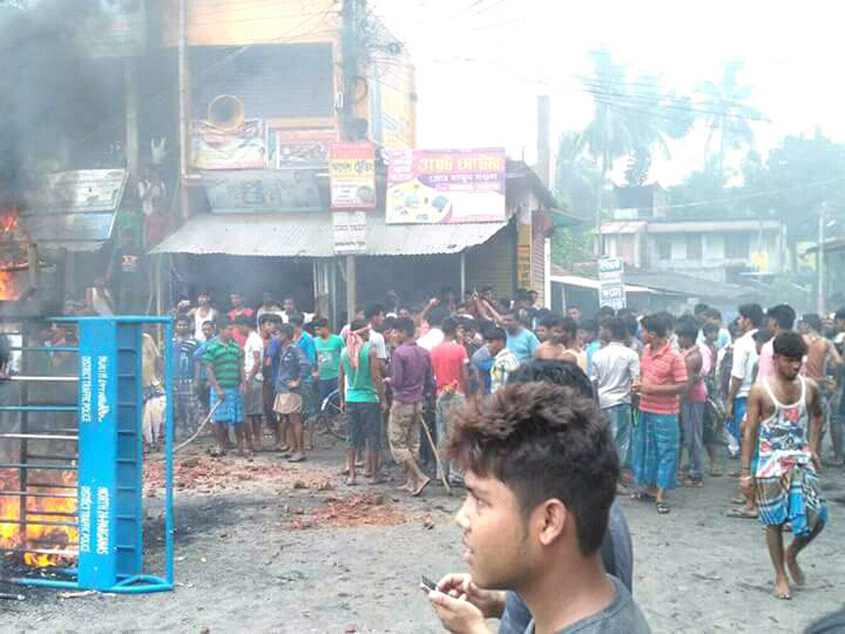Residents of the communal violence-hit Basirhat sub-division of West Bengal’s North 24 Parganas district said that the mobs that went around attacking members of the Hindu community in their area, were well organised to work towards spreading mayhem. They were armed with sticks, crude bombs and other country-made weapons. Locals also alleged that a Trinamool Congress MLA was in the forefront helping the local police search the homes of Hindu families and arrest “innocent” Hindu youths. The situation is still tense in Basirhat sub-division.
Rabin Ghosh (name changed), a resident of Baduria, which has been the epicentre of the communal violence that started on 2 July, said, “The violent mobs that have been ransacking our area are not made up of locals. We have been seeing since Monday that truckloads of people are coming to our area, shouting religious slogans, ransacking shops, hurling stones, crude bombs and leaving within 30-35 minutes. This clearly shows that the violence was organised and someone is supporting them.”
Locals also alleged that the mobs were being ferried to Basirhat from Kolkata’s Muslim-dominated areas of Rajarhat, New Town and Metiabruz, among others. Kolkata is barely 50 km from the riot-hit area. “These people are coming here, attacking our homes, shops, temples and moving out quickly. Of course they are being guided by the local minority population; as else, it is not possible for them to identify the Hindu majority places they should attack, but the locals are not coming to the forefront,” alleged Tarok, another resident. He added that the average age of the attackers is between 18 and 25 years. “All are young boys. You can barely see any old or middle aged man in the mob,” he said.
According to some local intelligence officials this correspondent spoke to, many of those who comprised the violent mobs were also infiltrators from Bangladesh. The Basirhat sub-division shares a long, porous, riverine border with Bangladesh. In fact, Bangladesh is barely 7 km from the epicentre of the riots. “There was nothing spontaneous about the entire incident. We are hearing that in the past two-three months, the local madrasas have admitted many residential students. We do not yet know their nationality or their hometown, but these students seem to have been involved in the rioting in Basirhat,” said an intelligence officer.
Communal violence broke out over a Facebook post, where an indecent and morphed picture of the desecration of a Muslim holy place was circulated allegedly by a 17-year-old boy from Baduria. Locals said that the boy, who had allegedly shared the picture with his friends, did not realise that it would lead to such violence. “The boy belongs to a very poor family and attends a government school in the neighbourhood. Apparently, his group of friends used to make religious jokes even earlier, but this time it did not go down well. Seeing the picture, it is hard to believe that the boy could morph it so professionally, as people here are not that tech savvy, especially keeping in mind his poor background,” a local, who did not wish to be named, said.
Obaidullah, another resident of Basirhat, said: “Violence spread like wildfire to neighbouring areas such as Hasnabad, Goalpara, Taki and Swarupnagar, among others. People were running after each other’s life. The incident also brought to the forefront many other issues between the two communities that had remained under the surface over the years. We have been asking for peace and calm in the area.”
Basirhat residents also accused the West Bengal police of not acting proactively when they received the information that communal riots had broken out. “The local police slept through 2 and 3 July, when the riots initially started. We kept calling the police, but they ignored our calls saying that it was a minor incident and we should be able to resolve it amongst ourselves. If they had acted on the first day itself, such a large area would not have been affected,” said Balaram (name changed), a local. He added that when the affected Hindu families kept calling the police for help, the police allegedly told them that they could not do much as they had been asked not to use force upon members of the Muslim community.
However, sources in the West Bengal government denied any such instructions being given to the police and said that the police had been asked to crack down upon anybody involved in rioting and anti-social activities, irrespective of religion.
Baduria, the epicentre of the riots, is said to be calm now, but reports of violence are still coming from the interiors of Basirhat and Taki. With restrictions on internet and telecom services, not much information is being reported from the interiors of the riot-hit areas.

